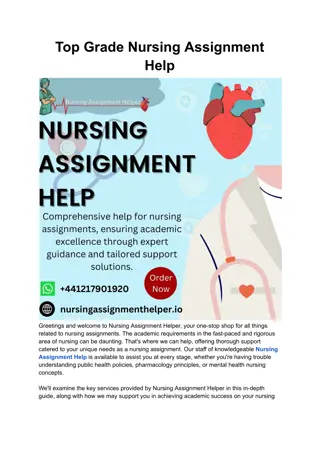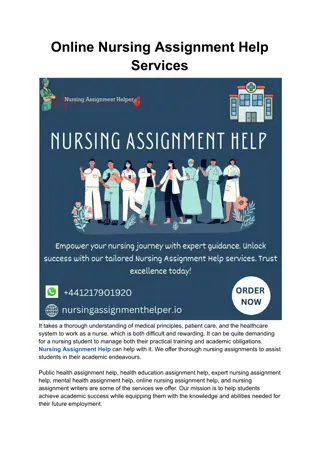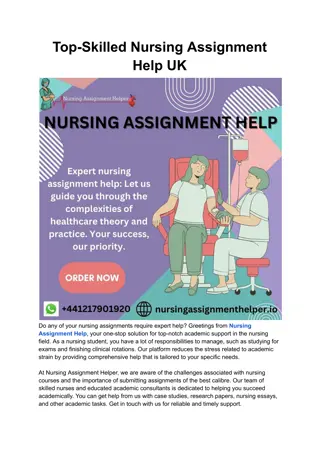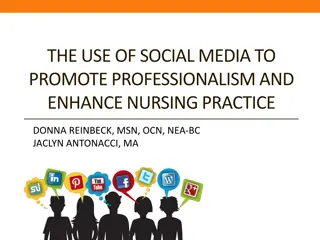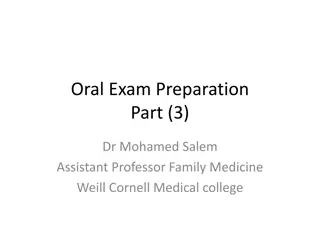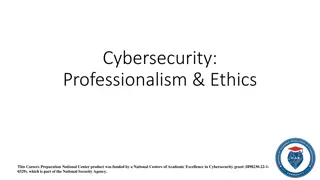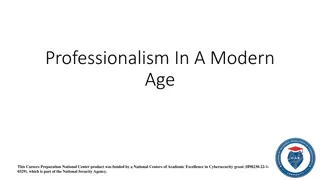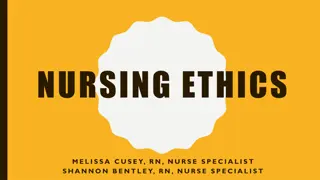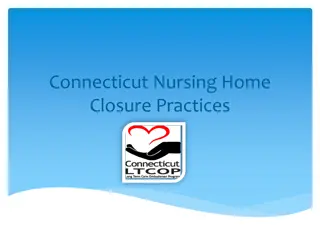Understanding Professionalism and Education in Nursing by Catherine Hrycyk
Explore the conceptual and philosophical basis of nursing through the insightful work of Catherine Hrycyk, focusing on the distinctions between a profession and an occupation, key terms in nursing, and the essential characteristics that define nursing as a profession. Delve into the importance of caring, specialized knowledge, intellectual activities, and accountability in the nursing profession.
Download Presentation

Please find below an Image/Link to download the presentation.
The content on the website is provided AS IS for your information and personal use only. It may not be sold, licensed, or shared on other websites without obtaining consent from the author. Download presentation by click this link. If you encounter any issues during the download, it is possible that the publisher has removed the file from their server.
E N D
Presentation Transcript
Professionalism and Education/ Conceptual and Philosophical Basis of Nursing Catherine Hrycyk, MScN, RN
Work with the colleague sitting next to you to discuss and answer the following questions (write the answers): 1. What are the differences between a profession and occupation ? 3. Define the following terms: 1. Value 2. Belief 3. Health 2
Occupation vs. Profession OCCUPATION PROFESSION Training may occur on the job. Education takes place in a college or university. Education is prolonged. Work involves mental creativity. Decision making is based largely on science or theoretical constructs (evidence-based practice). Values, beliefs, and ethics are an integral part of preparation. Commitment and personal identification are strong. Workers are autonomous. People are unlikely to change professions. Length of training varies. Work is largely manual. Decision making is guided largely by experience or by trial and error. Values, beliefs, and ethics are not prominent features of preparation. Commitment and personal identification vary. Workers are supervised. People often change jobs. Material reward is main motivation. Commitment transcends material reward. Accountability rests primarily with employer. Accountability rests with individual. 3
Eight Characteristics of a Profession (Kelly, 1981) 1. The services provided are vital to humanity and the welfare of society. Why do students want to become a nurse? To help people Caring is the core of professional nursing through which nurses intervene for their patients Caring in highly technologically advance healthcare environment: Nurses MUST focus on maintaining human aspects of caring How do nurses demonstrate caring? 4
Eight Characteristics of a Profession 2. There is a special body of knowledge that is continually enlarged through research. Research nursing degrees Nursing relies on theory and research as a basis for practice. Example: Evidence-based practice 5
Eight Characteristics of a Profession 3. The services involve intellectual activities; individual responsibility (accountability) is a strong feature. Critical and creative thinking serves as basis for providing nursing care. Example: Nursing process ANA defines accountability Accountability is firmly rooted in the ethical principles of fidelity (faithfulness), loyalty, veracity, beneficence, and respect for the dignity, worth, and self-determination of patients. 6
Eight Characteristics of a Profession 4.Practitioners are educated in institutions of higher learning. 1909: University of Minnesota first university-based nursing 1923: Yale first university based School of Nursing 1965: ANA Position Paper All nursing education should take place in institutions of higher education. Debate: Entry level into Practice 7
Eight Characteristics of a Profession 5. Practitioners are relatively independent and control their own policies and activities (autonomy). Autonomy control over one s practice. Licensure and autonomous practice Dotor sorders connotation Groups that control nursing practice Organized nursing Organized medicine Health service administration Magnet Recognition program and survey of nurses 8
Eight Characteristics of a Profession 6. Practitioners are motivated by service (altruism) and consider their work an important component of their lives. Altruism ideal of service to others Nurses altruism is sometimes questioned when they demand higher compensation and better working conditions. Collective bargaining 9
Eight Characteristics of a Profession 7. There is a code of ethics to guide the decisions and conduct of practitioners. 1893: Nightingale Pledge ICN and ANA established a Code of Ethics 10
Eight Characteristics of a Profession 8.There is an organization (association) that encourages and supports high standards of practice. American Nurses Association (ANA) official voice of nursing Purposes Relatively low percentage of nurses who belong to ANA and the constituent state nurses association A significant political influence is unrealized for the profession. 11
Barriers to Professionalism in Nursing Varying levels of education for entry into practice Lack of a standardized requirement for a minimum of a BSN, and preferably MSN (David, 2000) Gender issues Historic influences Religious and military background and obedience External conflicts Tension between medicine and nursing Internal conflicts Fragmented power and influence in professional nursing 12
Types of RN Education Programs Pre-licensure programs (entry to practice): Post-licensure programs: RN to BAN Diploma Advance practice programs: AND MSN BSN DNP Graduate pre-licensure programs (ELMS, ELDNP) Research degrees (doctoral degrees such as PhD, DSc) 13
Diploma Nursing Programs Peak: 1920 1930 ~200 programs in almost any state Mid 20th century dramatic decline caused by transfer of nursing education to the institutes of higher education Reasons for decline: Increasing complexity of healthcare environment Most colleges and universities did not recognize diploma programs. Current practice: Diploma programs establish agreements with colleges and universities. Hospital misused the programs to turn students into free labor 14
Baccalaureate Programs Required to qualify nursing as a recognized profession and to provide leadership in administration, teaching, and public health. 1909: First BSN program in University of Minnesota 4- 5 years programs including general education reqs + nursing courses. BSN graduates are eligible to take licensure exams, prepared to move into graduate programs and advanced practice certification programs. 2008 AACN. The Essentials of Baccalaureate Education for Professional Nursing Practice. 15
Associate Degree Programs Begun 1952, based on a model developed by Mildred Montag. Mildred Montag s ADN program: Short duration to prepare nurse technicians Nurse technicians function under supervision of professional nurses Routine care in acute and long-term settings Intended for end-point degree and not an incremental step to BSN Contrary to the original intent of ADN, the graduates received the right to sit for NCLEX-RN 16
Articulated Programs Definition: Mobility between programs Purpose: Facilitate opportunities to move up the educational ladder. Multiple-entry and multiple exit programs Articulation agreements facilitate student movement between programs and accept transfer credit between institutions. These result in acceleration or advanced placement. 17
RN to BSN and Graduate Entry Programs RN to BSN: Diploma and ADN nurses are given credits to meet certain BSN requirements. Transfer of general education courses Options for advanced placement Graduate entry programs: Accelerated or fast-track sequence to award a second bachelor s degree, MSN (ELMS), DNP 18
Accreditation: Ensuring Quality Education Accreditation voluntary review process of educational programs by a professional organization The accrediting agency compares the educational quality of the program with established standards and criteria. It derives authority from the US Department of Education. Two agencies: Accreditation Commission for Education in Nursing (ACEN) Accredits ALL nursing programs, not just RN programs Commission on Collegiate Nursing Education (CCNE) Baccalaureate and higher 19
Advance Practice Degrees: MSN Admission requirements: Active and unrestricted license BSN or equivalent AND Work experience 2 to 4 years, depending on focus Major areas of role preparation: Administration, case management, informatics, health policy/health care systems, teacher education, clinical nurse specialist, NP, nurse-midwifery, nurse anesthesia, and other clinical and nonclinical areas of study 20
Advance Practice Degrees: Doctorate Doctoral programs prepare nurses to become faculty members in universities, administrators in schools of nursing or large medical centers, researchers, theorists, and advanced practitioners. Research-focused degree doctor of philosophy (PhD) or doctor of science (DSc) Practice-focused degree doctor of nursing practice (DNP) DNP to become minimum requirement for advance practice 21
Conceptual and Philosophical Basis of Nursing Peter Miskin, DHSc, MScN, RN, PHN
Systems Theory Ludwig von Bertalanffy (1936): General Systems Theory Components of systems: Input, Throughput, Output, Evaluation, Feedback 23
Types of Systems Open system: An open system promotes the exchange of matter, energy, and information with other systems and the environment. Closed system: A closed system does not interact with other systems or with the surrounding environment. Sub-system: System that is a part of a large system Supra-system: The larger environment outside the system 24
Characteristics of Systems The whole is different from and greater than the sum of its parts (its subsystems). Synergy occurs when all the various subsystems work together to create a result that is not independently achievable. A change in one part of the system creates change in other parts. There is continuous exchange of energy and information WITHIN open systems BETWEEN open systems Supra-systems Dynamic balance within and between subsystems, systems, and supra- systems helps create and maintain homeostasis. 25
Key Concepts about Systems A system is a set of interrelated parts. The parts form a meaningful whole. The whole is different from and greater than the sum of its parts. Systems may be open or closed. All living systems are open systems. Systems strive for homeostasis (internal stability). Systems are part of supra-systems. Systems have subsystems. A change in one part of a system creates change in other parts. 26
Fundamental Nursing Concepts CONCEPT 1: Person: An open system with human needs An individual Each individual is an open system with numerous subsystems. Each person is unique determined genetically, environmentally, and experientially. Human needs required for a person s well-being Maslow (1954) Motivation and Personality: Human behavior is motivated by intrinsic needs. He identified five level of needs. 27
Maslows Hierarchy of Needs Physiologic needs food, oxygen, rest, activity, shelter, and sexual expression I. Physical and psychological safety and security reasonably predictable environment with which one has some familiarity and relative freedom from fear and chaos II. Love and belonging close intimate relations, social relations, a place in the social structure III. Self-esteem need to feel self-worth, self-respect, and self- reliance IV. Self actualization realized maximum potential V. 28
Assumptions About Maslows Hierarchy Basic needs must be at least partially satisfied before higher-order needs can become relevant to the individual. Individuals meet their needs in different ways. The manner the needs are met and the extent by which these are considered needs vary according to each individual. Individualized nursing care 30
Adaptation and Human Needs Carl Rogers (1961) On becoming a Person A person s needs change as the person changes. Concept of adaptation People admitted in hospitals and removed from their usual environments commonly become anxious. 31
Homeostasis Homeostasis is a dynamic balance achieved by effectively functioning open systems. Homeostasis is attained by coordinated responses of organ systems that automatically compensate for environmental changes. Individuals, as open systems, also endeavor to maintain balance between external and internal forces. When balance is achieved, the person is healthy or is resistant to illness. If adaptation is unsuccessful, disequilibrium may occur, setting the stage for the development of illness or disease. 32
Fundamental Nursing Concepts CONCEPT 2: Environment: The supra-system in which a person lives in. The environment can either promote or interfere with homeostasis and well-being of individuals. In Maslow s hierarchy of needs, there is a dynamic interaction between a person s needs (internal) and the satisfaction of those needs (often environmentally determined). 33
Environmental Systems Family system Family defined Nuclear and extended family Cultural systems Social systems: Communities States Nations Supra-national International 34
Environmental Systems Nurses potential impact on the environment/supra- system Ecological health Healthy work environments WHO training modules including mercury poisoning Health Care Without Harm to reduce hazardous waste Luminary Project 35
Fundamental Nursing Concepts CONCEPT 3: Health as a continuum Definition vary Health beliefs models: Rosenstock s Health Beliefs Model Bandura s Theory of Self-efficacy Locus of control : Internal locus of control External locus of control 36
Nursing: Forming the Meaningful Whole Holistic nursing care nourishes the whole person the body, mind, and spirit. Eight factors contribute to holistic approach to nursing 1. Nursing is an open system 2. Nursing is the provision of health care services 3. Nursing involves collaborating with patients and their families 4. Nursing is integrally involved with people 5. Nursing care is provided regardless of diagnosis, individual differences, age, beliefs, gender, sexual orientation, or other factors. 6. Nurses require advanced knowledge and skills 7. Nursing requires concern, compassion, respect, and warmth, as well as comprehensive, individualized planning of care, to facilitate patients growth toward wellness. 8. Nursing links theory and research 38
Beliefs Guiding Nursing Behaviors Beliefs: What are beliefs? Attitudes and behaviors Belief systems serve to guide thinking and decision- making Types: Descriptive or existential beliefs Evaluative beliefs Prescriptive (encouraged) and proscriptive (prohibited) beliefs 39
Values Freely chosen principles, ideals, or standards held by an individual, class, or group that give meaning and direction to life. Abstract representation of what is right, worthwhile, or desirable. Relatively stable and resistant to change. Three Steps in Valuing Choosing is the cognitive (intellectual) aspect of valuing. Prizing is the affective (emotional) aspect of valuing. Acting is the kinesthetic (behavioral) aspect of valuing. 1. 2. 3. All three steps must be taken or the process of valuing is incomplete. 40
Values Clarification Identify some of your nursing values based on reactions to these statements. Patients should always be told the truth about their diagnoses. Nurses, if asked, should assist terminally ill patients to die. Severely impaired infants should be kept alive, regardless of their future quality of life. Nurses should never accept gifts from patients. A college professor should receive a heart transplant before a homeless person does. Nurses should be role models of healthy behavior. 41







